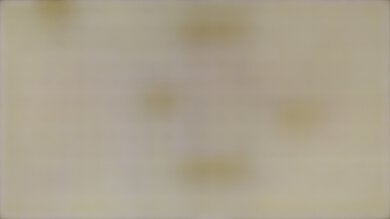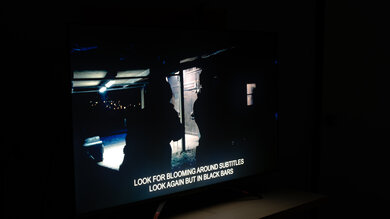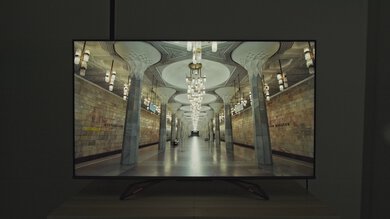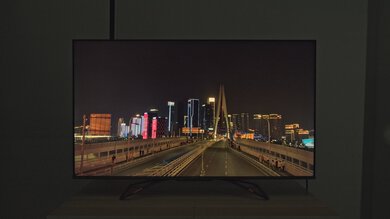The Hisense U8G is a high-end 4k TV in Hisense's 2021 lineup. It replaces the 2020 Hisense H8G, and it's been replaced in 2022 by the Hisense U8/U8H. It offers an impressive array of additional features, including HDMI 2.1 bandwidth, 4k @ 120Hz gaming for PS5 and Xbox Series X gamers, and FreeSync variable refresh rate support. It runs the Android 10 smart interface, which has a great selection of additional streaming apps, including all major streaming services. Sadly, even though these sizes are the most popular, it's only available in 55-inch and 65-inch sizes, which is disappointing if you're limited in space or looking for something bigger.
Our Verdict
Overall, the Hisense U8G is an impressive TV. Thanks to its excellent contrast ratio, high peak brightness, and great local dimming feature, it's a great choice for watching movies in a dark room. It also looks great in a bright room for watching shows or sports, and it easily overcomes bright glare, but it has a narrow viewing angle, so it's not ideal for a wide seating arrangement, as the image degrades at the sides. It has outstanding low input lag, an excellent response time, and great gaming features like variable refresh rate (VRR) support, making it an excellent choice for gaming or use as a PC monitor. Overall, it's a well-rounded TV that should please most people.
- Outstanding contrast.
- High peak brightness.
- Excellent reflection handling.
- Excellent response time.
- Image degrades when viewed at an angle.
The Hisense U8G is a great TV for watching TV shows during the day. It has great reflection handling and high peak brightness, so glare isn't an issue even in very bright rooms. It's not perfect, though, as the image degrades when viewed at an angle, which is an issue if you like to move around with the TV on. The built-in Google Play Store has a huge selection of apps, so you're sure to find your favorite streaming service without resorting to an external streaming box.
- High peak brightness.
- Excellent reflection handling.
- Image degrades when viewed at an angle.
The Hisense U8G is a great TV for watching sports in a bright room. It has excellent reflection handling and great peak brightness, so glare isn't an issue in bright rooms. It has a fast response time, so fast action is clear, and it's easy to make out the action on-screen. On the other hand, the image degrades when viewed at an angle, so if you like to watch the big game with a large group of friends, only those seated directly in front of the TV will enjoy it to the fullest.
- High peak brightness.
- Excellent reflection handling.
- Excellent response time.
- Image degrades when viewed at an angle.
- Some noticeable dirty screen effect.
The Hisense U8G is an amazing TV for playing video games. It has outstanding low input lag for a responsive gaming experience, and a great response time, so fast action is clear. It's great for console gamers, with support for 4k @ 120Hz gaming from the Xbox Series X or PS5, and it supports variable refresh rate technology to reduce tearing. Games look great thanks to the excellent contrast ratio, and local dimming performs just as well in 'Game' mode as in other picture modes. It's also extremely bright and has great reflection handling, so glare isn't an issue.
- Outstanding contrast.
- High peak brightness.
- Outstanding low input lag.
- Excellent response time.
The Hisense U8G delivers an excellent HDR movie experience. It has an excellent contrast ratio, delivering deep blacks, and the local dimming feature is great, resulting in bright highlights that stand out, with minimal blooming. It gets extremely bright when displaying HDR content, and small specular highlights stand out well, but it doesn't track the PQ EOTF very well, as most scenes are brighter than they should be. HDR movies look vivid and realistic thanks to the impressive color gamut.
- Outstanding contrast.
- High peak brightness.
- Excellent black uniformity.
- Most scenes are brighter than they should be.
- Noticeable stutter in low frame rate content.
The Hisense U8G is an excellent TV for HDR gaming. It has impressive low input lag, a fast response time, and great gaming features, including Auto Low Latency Mode and support for a variable refresh rate. Image quality isn't hindered in Game mode, with the same great local dimming performance and high peak brightness as outside of Game mode. HDR content looks amazing, thanks to its excellent contrast ratio and great local dimming feature, so bright highlights in games really stand out and look realistic.
- Outstanding contrast.
- High peak brightness.
- Outstanding low input lag.
- Excellent response time.
For the most part, the Hisense U8G is a great choice for a PC monitor. It has extremely low input lag, ensuring smooth mouse movements and a responsive experience in general, and it has a great response time. It also has great reflection handling, so glare isn't an issue. Unfortunately, the image degrades when viewed at an angle, so you'll need to sit a comfortable distance from the screen; otherwise, the sides of the screen won't look the same. Also, like most TVs, it uses a BGR subpixel layout, which reduces text clarity a bit, but there are workarounds for this.
- Outstanding low input lag.
- Excellent response time.
- Image degrades when viewed at an angle.
Changelog
- Updated Sep 26, 2025: We uploaded the latest brightness measurements and uniformity photos for the Accelerated Longevity Test.
- Updated Jul 08, 2025: We uploaded the latest brightness measurements and uniformity photos for the Accelerated Longevity Test.
- Updated Apr 17, 2025: We uploaded the latest brightness measurements and uniformity photos for the Accelerated Longevity Test.
- Updated Feb 11, 2025: We uploaded the latest brightness measurements and uniformity photos for the Accelerated Longevity Test.
Check Price
Differences Between Sizes And Variants
We tested the 55-inch Hisense U8G (55U8G), and our results are also valid for the 65-inch (65U8G) model. In Canada, this model is known as the Hisense U88G. Unfortunately, Hisense TVs released internationally are completely different from the U.S. models, so the Hisense U8G and the Hisense U8GQ released outside of North America don't perform the same.
| Size | US Model | Canada Model | Local Dimming Zones |
|---|---|---|---|
| 55" | 55U8G | 55U88G | 132 |
| 65" | 65U8G | 65U88G | 360 |
If someone comes across a different type of panel or their Hisense U8G doesn't correspond to our review, let us know, and we'll update the review.
The unit we tested was manufactured in March 2021, and you can see the label here.
Popular TV Comparisons
The Hisense U8G is an impressive TV, with a few minor issues that could be deal-breakers for some. It offers impressive value, outperforming some far more expensive models from competitors, like the Sony X90J.
See our recommendations for the best 4k TVs, the best 55-inch TVs, and the best 4k gaming TVs.
The Hisense U8H is a bit better than its predecessor, the Hisense U8G. The U8H has a more effective local dimming feature, significantly increasing contrast with local dimming enabled. The U8H is also a lot brighter, and it displays HDR content much closer to the content creator's intent. Finally, the U8H has been updated to the latest Google TV interface, which is a bit faster and smoother than the older Android TV interface on the Hisense U8H.
The Samsung QN90A is a bit better than the Hisense U8G. The Samsung has better viewing angles, making it a better choice for a wide seating arrangement, and the local dimming feature is more effective at reducing black levels, improving contrast. The Samsung is also significantly brighter, but since the Hisense is also very bright, the difference is only noticeable with some content.
The Hisense U8G is better than the Hisense U7G. The U8G has better reflection handling and higher peak brightness, so it can more easily overcome glare in a bright room. The U8G also has a better local dimming feature, better black uniformity, and the unit we bought is more accurate out of the box. Finally, the U8G has a faster response time and a slightly wider color gamut.
The Hisense U8G is better than the Sony X90J. The Hisense has higher peak brightness, and small highlights in some scenes stand out more in HDR. The Hisense also has better black uniformity, much better reflection handling, and it can display a wider color gamut. On the other hand, the Sony has less banding in areas of similar color, and the motion interpolation feature is a bit more polished, with fewer artifacts in busy scenes.

We buy and test dozens of TVs yearly, taking an objective, data-driven approach to deliver results you can trust. Our testing process is complex, with hundreds of individual tests that take over a week to complete. Most of our tests are done with specially designed test patterns that mimic real content, but we also use the same sources you have at home to ensure our results match the real-world experience. We use two main tools for our testing: a Colorimetry Research CR-100 colorimeter and a CR-250 spectroradiometer.
Test Results

The Hisense U8G has a nice, premium design. It has a nearly bezel-less design on three sides, so the picture blends into your surroundings. The bottom bezel is quite a bit thicker than high-end TVs, though, and the silver finish stands out a bit. The stand has a unique design that takes up very little space.
The back of the TV is made of plastic, with a nice checkerboard pattern. There are tracks along the back of the TV for cable management, and removable clips that help to keep everything neat. The inputs are on the left-hand side of the TV when facing the front, and they're easy to access. There are large vents along the top of the TV to help with heat dissipation.
The Hisense U8G has good build quality. The stand supports the TV well, with little wobble. The materials used aren't very premium, but they don't feel cheap, either. The border around the screen is metal, but most of the body is plastic. There's very little flex, except around the VESA mounts, but this shouldn't cause any issues.
The Hisense U8G has outstanding contrast, delivering deep blacks and bright highlights in dark scenes with minimal blooming. The full array local dimming feature is effective at boosting contrast significantly, but it's not as good as the newer Hisense U8/U8H, which delivers nearly twice the contrast with local dimming.
The Hisense U8G has impressive peak brightness in HDR. Small specular highlights are brighter than the Hisense H9G and significantly brighter than the Sony X90J. These measurements are in the 'HDR Theater' Picture Mode, which is the brightest and the most accurate HDR mode on this TV.
Switching to Game Mode results in no noticeable change in peak brightness with HDR content. These results are with the same picture settings as outside of Game Mode.
Unfortunately, the Hisense 55U8G doesn't follow the EOTF properly, as almost all scenes in HDR are displayed a bit brighter than they should be. It's especially noticeable in most average-lit scenes and shadow details, but near blacks are displayed accurately. There's also a very sharp roll-off at the TV's peak brightness, which clips bright highlights, causing a loss of fine details in extremely bright scenes. The IMAX mode tracks the EOTF accurately, but almost all settings are locked out in this mode. Unfortunately, there's no way to correct this, but there are reports that the TV tracks the PQ EOTF properly with Dolby Vision content.
The Hisense U8G has excellent peak brightness in SDR, but it's not as bright as the newer Hisense U8/U8H. It's bright enough to overcome glare even in most bright living rooms. Unfortunately, the brightness varies considerably between scenes, but this is only noticeable if you have the backlight set to a high level. If you want something with Mini LED backlighting that gets much brighter with real content, then check out the TCL 6 Series/R646 2021 QLED.
These measurements are after calibration in the 'Theater Night' Picture Mode with the Backlight set to 'Max' and Local Dimming to 'High'. Setting Active Contrast to 'Medium' results in a slightly brighter picture of 1,401 cd/m² in the 25% window, but it isn't a very noticeable difference.
The Hisense U8G has an excellent HDR color gamut, with nearly perfect coverage of the DCI-P3 color space used by most current HDR content and good coverage of the wider Rec. 2020 color space. The tone mapping is good in both cases, ensuring fine details are preserved in content that exceeds or approaches the limits of the TV's color gamut.
The Hisense U8G has excellent color volume. Saturated colors get very bright, and it has excellent coverage of the DCI-P3 color space at all luminance levels. Thanks to the high contrast ratio, this TV displays dark, saturated colors well.
Out of the box, the Hisense U8G has excellent color and white balance accuracy in SDR. There are some noticeable inaccuracies in certain colors, especially with shades of blue. However, the white balance is excellent, and gamma is nearly flat, close to our target of 2.2 for a moderately-lit room.
As the Hisense U8G already had excellent accuracy out of the box, calibration was tough to do and didn't improve the overall accuracy much. Color accuracy improved a bit, but the issues with shades of blue are still there. The white balance is now nearly perfect, but as it was already excellent, this isn't a noticeable improvement.
You can see our full calibration settings here.
The Hisense U8G has decent gray uniformity. The corners are noticeably darker than the center of the screen, and there are three dark vertical bands near the center of the screen. There's a bit of dirty screen effect as well, which is distracting when watching sports or anything with a large area of uniform color. Dark scenes are a bit better, with significantly less dirty screen effect.
The Hisense 55U8G has excellent black uniformity. With local dimming disabled, the black background isn't quite black, with slight cloudiness to the entire screen caused by some backlight bleed on all four corners. Enabling local dimming significantly improves uniformity in dark areas of the screen, but there's more blooming around the bright test cross.
Unfortunately, the Hisense U8G has a sub-par viewing angle, so it's best enjoyed from directly in front. The image shifts and degrades when viewed off-angle, so it's not ideal for a wide seating arrangement or if you like to move around with the TV on. The most noticeable issue off-angle is the gamma shift, which causes the image to appear washed out. Colors stay accurate to a wider angle than the gamma, but it's not as good as IPS-type TVs like the LG NANO90 2021.
Like most TVs on the market, the Hisense U8G uses a BGR (Blue-Green-Red) subpixel layout instead of the traditional Red-Green-Blue layout. For video content, it doesn't cause any issues, but if you're planning on using the Hisense 55U8G as a PC monitor, this reduces text clarity a bit, although there are easy workarounds for it. You can read more about this here.
For the most part, the Hisense U8G has an excellent response time, resulting in clear motion in fast-moving scenes. Unfortunately, there are some exceptions. Transitions out of dark scenes have significantly slower transitions, resulting in noticeable ghosting behind fast-moving objects. It's common for displays with VA panels, though, and is known as black smear.
Like the Hisense H9G, there are reports of red ghosting in some situations. It's not always there, but it's very clear with some content, like The Crown, or in Daredevil. It's not noticeable in all content but seems to be more noticeable in warmer scenes. It's not noticeable in all games, either. There's no ghosting in Call of Duty, but it's really bad in Astro's Playground on the PS5:
The Hisense U8G uses Pulse Width Modulation (PWM) to dim the backlight, but the flicker frequency is very high and doesn't bother most people. There's no variability in flicker between different settings, though; it flickers at the same frequency in all picture modes.
The Hisense U8G has an optional backlight strobing feature, commonly known as black frame insertion, which improves the appearance of motion. It can't flicker at 60Hz, though, which causes duplications in motion when displaying 60Hz content. Unfortunately, enabling this feature disables the local dimming feature, resulting in raised blacks. Note that the score here is based only on the supported modes, not how well the BFI feature performs.
The Hisense U8G has an optional motion interpolation feature that improves the appearance of motion. It's not as good as more expensive competitors, like the Sony X90J or the Samsung QN90A QLED, and there are more noticeable artifacts, especially in busy scenes.
Due to the Hisense U8G's relatively fast response time, there are some issues with stutter with 24p content, like movies, as each frame is held longer on screen. It's especially noticeable in slow panning shots.
The Hisense 55U8G automatically removes judder from any source, ensuring a smooth movie-watching experience.
The Hisense 55U8G supports a variable refresh rate (VRR), and it's compatible with most sources that support VRR, including from an NVIDIA graphics card. Unfortunately, enabling VRR causes more ghosting in some games, and local dimming isn't available with VRR enabled in Game Mode.
The Hisense U8G has outstanding low input lag, great for gaming or PC use. The 60Hz input lag is a bit higher than the best TVs on the market at the moment and about double the input lag of most monitors at 60Hz, but still low enough for most people. When running at 120Hz, the input lag is on par with the best TVs on the market and very close to most monitors. It's great for a responsive feel when gaming or using it as a PC monitor.
The Hisense U8G displays 1440p resolutions, but these formats aren't exposed in the EDID, so you have to force it. You can do this either through custom HDMI settings on an Xbox or through your graphics card's control panel software as a custom resolution. As of firmware update M0210, released in March 2022, 4k @ 120Hz signals are now displayed properly from sources that support HDMI 2.1 bandwidth; the resolution halving issue has been fixed. Chroma 4:4:4 is displayed properly at this resolution and refresh rate, resulting in clear text.
The Hisense U8G supports all the features of the PS5, but there are a few issues. 4k @ 120Hz displays properly as of firmware update M0210, but, unfortunately, this introduced some issues with consoles. HDR is no longer displayed properly from the PS5 with any signal, as colors appear washed out, and the entire image is over-brightened. Local dimming isn't working properly in this mode either, and the Active Contrast feature doesn't appear to be working. These issues only occur with the PS5 or Xbox Series X; HDR displays properly from a PC, and both local dimming and Active Contrast appear to be working properly.
Except for 120Hz Dolby Vision, the Hisense U8G supports all the Xbox One S|X's features, but there are a few issues. 4k @ 120Hz displays properly as of firmware update M0210, but, unfortunately, this introduced some issues with consoles. HDR is no longer displayed properly from the Xbox Series X with any signal, as colors appear washed out, and the entire image is over-brightened. Local dimming isn't working properly in this mode either, and the Active Contrast feature doesn't appear to be working. These issues only occur with the PS5 or Xbox Series X; HDR displays properly from a PC, and both local dimming and Active Contrast appear to be working properly.
New to the 2021 models, the Hisense U8G now has two HDMI 2.1 ports. One of them is also the eARC port, so if you're planning on using an eARC device, you can only connect one other HDMI 2.1 device on the TV.
There's no direct connection for composite sources. Instead, it requires an external breakout adapter (included), similar to some LG TVs.
The Hisense U8G supports eARC and can pass all the common formats through to a support receiver or soundbar.
The Hisense U8G has a decent frequency response, similar to the Hisense H9G. As usual for a TV, there's almost no low bass, so it can't produce any rumble or thump. It's a bit boomy in the high-bass and mid to high treble sounds are a bit under-emphasized, but otherwise, it has a well-balanced sound profile and can get quite loud.
This TV has an okay distortion performance. There's some audible total harmonic distortion, but mainly at high volume levels; it's not noticeable at moderate volume.
The Hisense U8G's smart interface has been updated to Android 10, from Android 9.0 on the 2019 models. The interface has changed a bit, and the overall experience is much smoother and faster. The interface is very similar to the new Google TV interface on 2021 Sony TVs, like the Sony X90J, but there are some slight differences.
The remote has a built-in mic for voice control, and it works well for launching apps or changing inputs, but you can't use it to adjust settings on the TV. There's also a mic built-in to the TV for voice control. Unfortunately, as of firmware update M0210, it's not working consistently. Some owners have reported that installing the firmware update over USB fixes it.
























































